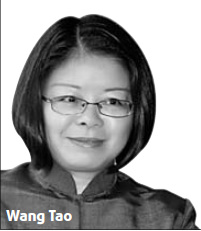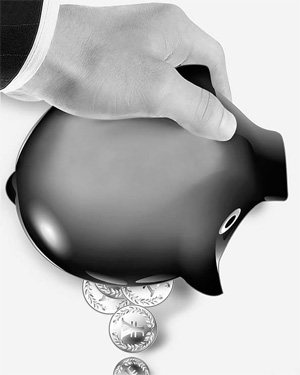

Editor's Note: China's recent strong performance in economic growth and the equity markets has led to many cheers and also many doubts.
In a recent report, UBS Securities economist Wang Tao said she believes China's growth can be sustained. She projects that macro policy will be adjusted to avoid a major boom-bust cycle.

However, Wang pointed out that the slowdown of new bank lending in coming months might negatively affect investor sentiment in the asset market, which could trigger some corrections in prices.
"Under that assumption and the expectation of a modest recovery in the global economy, we see GDP growth at 8.2 percent and 8.5 percent in 2009 and 2010, respectively," Wang said.
"We expect year-on-year growth to get stronger each quarter in 2009 and bring along with it underlying demand for commodities and investment goods," she said. "We also expect GDP growth to slow in 2010 from the peak in the fourth quarter of 2009 or the first quarter of 2010."
Wang elaborated on her outlook for China's economy in a recent interview with China Business Weekly.
Q: Is it all just government stimulus programs, and how long can that last?
A: Growth so far has mainly come from government stimulus programs financed by fiscal spending and, more importantly, bank lending.
Going forward, the recovery of property construction is key to help sustain domestic demand, while the negative contribution from net exports is also expected to wane.
Both should help to offset the eventual tapering off of the stimulus.
Q: Is most of the lending going to sectors with excess production capacity?
A: Not by design. The stimulus is focusing on infrastructure instead of productive capacity in the manufacturing sector.
Investment in sectors with obvious excess capacity such as the steel sector, or export-oriented sectors that are facing a weak outlook such as textile and electronics, has been very weak.
Q: Has the majority of new bank lending gone to speculate on the asset market?
A: We don't think so. While money is fungible and the excess liquidity in the economy has almost certainly contributed to the rise in asset prices, most new loans seem to have gone to the real economy.
Total new bank lending reached 7.4 trillion yuan in the first half of the year, of which about 12 percent was mortgage lending or loans to property developers.
Total net inflow to the stock market was 450 billion yuan, while the combined import bill of basic metals and coal was little more than 200 billion yuan in the first half of 2009. Clearly these markets could not have absorbed a substantial share of bank lending.
Q: Will a moderation of new bank lending lead to a sharp drop in growth?
A: No. First, bank lending has always been front-loaded, and spending is smoother and has a time lag. We believe that investment in the coming months will continue to be well supported by lending that has already taken place.
Second, liquidity does not just disappear. There is a lagged spillover effect, and we have already seen non-SOE investment picking up recently.
Third, increased activity, a better outlook and an expected turnaround in corporate earnings will boost "autonomous" investments.
Q: Will China tighten its lending policy?

A: We do not expect an overall tightening in the form of strict lending quotas or interest rate hikes any time soon, given the need to support growth and little consumer price index (CPI) inflationary pressure.
However, the policy is turning from an extremely expansionary position to accommodative stance. Concerns about the asset market bubble and future non-performing loans (NPL) have increased.
We expect increased sterilization to slow liquidity creation in the banking system. We anticipate enforcement of prudent regulations to limit credit risks, and also measures to prevent an asset bubble from threatening the financial sector or social stability.
Q: How much new lending can we expect in 2009 and 2010?
A: We see total new bank lending reaching about 10 trillion yuan in 2009 and declining to 7 trillion yuan in 2010 (16 percent year-on-year growth).
Q: Are banks headed for an explosion of non-performing loans?
A: Yes, if new bank lending continues at more than 1 trillion yuan a month for much longer. However, we think lending will moderate in coming months.
Even so, we do expect NPLs to rise, probably significantly, as they usually do when credit expands rapidly during an economic downturn.
We expect the NPLs to hurt banks' profits and balance sheets, and the situation might require some government bailouts at the end.
However, we do not expect NPLs to come close to the high levels of the late 1990s, and we do not expect banks' ability to intermediate to be impaired. Nor do we expect a financial crisis.
Q: Shouldn't China be focusing on boosting consumption?
A: Over the medium term, China should try to reduce its reliance on investment and boost domestic consumption.
In the short run, however, it is very difficult to boost consumption, since it requires increasing employment and consumer confidence in an economic downturn.
Moreover, consumption has remained resilient while investment was falling significantly in the beginning of the downturn. Stimulating investment is the most effective way to boost GDP growth.
The government is aware of the imbalance in the economy and has started to implement measures to improve the social safety net (such as health care) and reform some of the domestic distortions. But it will take time and more effort for the growth model to change.
Q: What is the implication for investors?
A: We expect year-on-year growth and underlying demand for investment goods to get stronger in the next two to three quarters, and see corporate earnings improving by the end of 2009.
However, the slower flow of liquidity and new bank lending could negatively affect investor sentiment and asset prices, as could some policy measures aimed at preventing a speculative bubble, including efforts to increase the supply of tradable shares and large IPOs in the equity market.
This correction in prices is likely to happen in the third quarter.
In addition, we expect the additional effect of the stimulus to decline in 2010, leading to a slowdown in quarterly GDP growth in the second and third quarter of 2010 from the peak of the fourth quarter of 2009 or the first quarter of 2010, even as we expect a sustained recovery in housing and a turnaround in net exports.
(China Daily 08/17/2009 page2)













